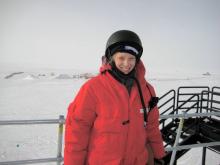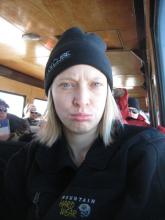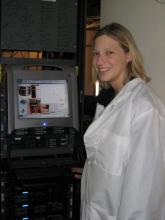Update
PolarConnect webinars were held with Katey Shirey and the Team from the IceCube: In-ice Antarctic Telescope project on 2 and 6 December 2010. Access the Archives!
What Are They Doing?
A large international team of scientists and drilling technicians worked throughout the austral summer to continue assembling and testing the world's largest scientific instrument, the in-ice IceCube Neutrino Detector. Neutrinos are incredibly common (about 10 million pass through your body as you read this) subatomic particles that have no electric charge and almost no mass. They are created by radioactive decay and nuclear reactions, such as those on the sun and other stars. Neutrinos rarely react with other particles or forces; in fact, most of them pass through objects (like the earth) without any interaction. This makes them ideal for carrying information from distant parts of the universe, but it also makes them very hard to detect. All neutrino detectors rely on observing the extremely rare instances when a neutrino does collide with a proton. This collision transforms the neutrino into a muon, a charged particle that can travel for 5-10 miles and generate detectable light.
IceCube was constructed in Antarctica because the huge amount of dense ice under the South Pole contains a lot of protons that can be hit by passing neutrinos, and the ice is transparent, so the resulting light can be caught by sensors. IceCube is made up of 4200 sensitive light detectors embedded in the ice at depths between 1450 and 2450 meters (4700-8000 feet). The sensors are deployed on "strings" of 60 modules each, into holes 60 centimeters in diameter melted in the ice using a hot water drill. Covering about one square kilometer, IceCube expands on an existing experiment that started detecting neutrinos at the South Pole in 1997.
The data collected was used to make a "neutrino map" of the universe and to learn more about astronomical phenomena, like gamma ray bursts, black holes, and exploding stars, and other aspects of nuclear and particle physics. However, the true potential of IceCube is discovery; the opening of each new astronomical window has led to unexpected discoveries.
Miss Shirey’s participation in PolarTREC and IceCube was in coordination with a wide array of teachers through the Knowles Science Teaching Foundation. These teachers had planned and practiced activities related to IceCube with students in the 2009 and 2010 summers. They coordinated activities and mini-experiments that were performed at the pole in the winter of 2009 by PolarTREC Teacher, Casey O'Hara. They communicated across America and across the world with researchers, teachers, and other classes. Emphasizing communication and interconnectedness, Katey's trip to the Pole involved even more classrooms and reached even more parts of America.
Where Are They?
The team worked at the Amundsen-Scott South Pole Station in Antarctica – the southernmost continually inhabited place on the planet. The IceCube site is about one kilometer from the new South Pole Station, which supplies the necessary logistics of food, power, and shelter. The South Pole is reached by plane from McMurdo Station on the coast of Antarctica from October through February when temperatures become too low for planes to safely operate. Approximately 50 people stay there the rest of the year, which is known as wintering over. IceCube has two to three people dedicated to overseeing the operation of the telescope during this period at the South Pole.
Latest Journals

Dr. Madsen is the chair of the Physics Department at UW-River Falls and Associate Director of the IceCube Neutrino Observatory where he directs the education and outreach program. His research interests include heliophysics and astrophysics, which he has studied at his various projects in Antarctica. In addition to research, Dr. Madsen is committed to reaching a broad audience beyond the research community. He is involved in education and outreach for the IceCube project including professional development courses for teachers and science and math instruction for the UWRF Upward Bound Program. He collaborates with a number of programs and institutions in addition to PolarTREC, including the Knowles Science Teaching Foundation, UW-River Falls Upward Bound and McNair Programs, and service groups (Rotary International, Boy and Girl Scouts, university alumni associations, etc.). You can read more about Dr. Madsen's work here and here.
"Working in Antarctica is a wonderful adventure, and it is great to provide opportunities for others to have this awesome experience."





